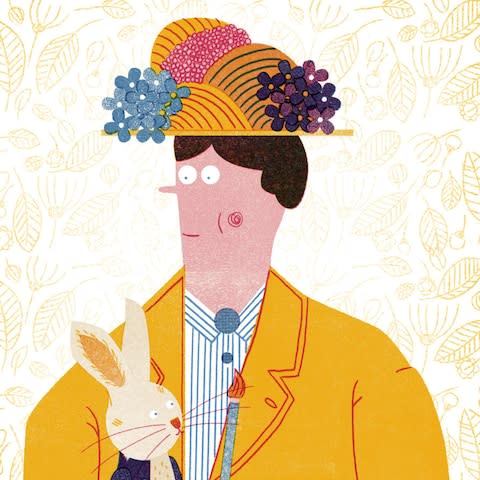Return of the Rebel Girls: the runaway success stories of women who changed the world

Francesca Cavallo is telling me a story, and it’s clearly one she’s especially fond of. The setting is a classroom; the event, a careers day. The pupils are being asked about the work they’d like to do; but when a girl pipes up that her dream job is to be a surgeon, a boy sitting near her snorts. Girls can’t be surgeons, he tells her. “And do you know what that girl did, when she heard his remark?” asks Cavallo. “She didn’t get angry, or upset, or tell him he was stupid. She simply said, ‘Oh! He hasn’t read Rebel Girls...’.”
To the lexicon of books that have changed the world, Good Night Stories for Rebel Girls can now be added. It’s edited by Cavallo and her partner in life as well as in books, Elena Favilli: the pair have been in a civil partnership since 2016. Published just under a year ago in the UK after the most successful-ever crowdfunding for a children’s book (pledges exceeded the goal of $40,000 by an astonishing $635,000), it has now sold over a million copies worldwide, and been translated into more than 40 languages.
Published just under a year ago in the UK after the most successful-ever crowdfunding for a children’s book, it has now sold over a million copies worldwide, and been translated into more than 40 languages
This week sees the publication of volume two, with the add-on of a new podcast launching next week; and it’s a pretty safe bet to say that, if your child goes to school tomorrow dressed as one of the Rebel Girl heroines for World Book Day, rather than as Hermoine Granger, Cinderella or Katniss Everdeen, say, she’s absolutely on-trend for 2018.
What’s most stunning about the Rebel Girls phenomenon isn’t how wildly successful it’s been, or even how in the digital age a book can still be a global game-changer. No: the most extraordinary thing is that, in our so-called enlightened times, we were so thirsty for a project about something as simple as telling women’s stories.
Because that is all Rebel Girls does: volume one told 100 stories of women as diverse as Cleopatra, Margaret Thatcher and Maya Angelou; volume two adds amongst others the tales of JK Rowling, Oprah Winfrey and Beyoncé. Each woman’s entry is accompanied by a lively and colourful illustration; but it is the simplicity of the project that takes your breath away.

Like all the most potent ideas, it’s what lies behind the Rebel Girls phenomenon that explains why it’s been so successful. Because the surprising truth is that, as women’s lives have changed over the last few centuries, history has not; and literature, it turns out, has been pitifully slow to take account of the alterations. Of 6,000 children’s books surveyed in 2011, all published between 1900 and 2000, only 37 per cent had any speaking female characters at all.
Meanwhile the teaching of history in school, remains fundamentally the telling of the stories of powerful male figures. “In the UK you’re lucky because you have queens: not every country has the story of women like Elizabeth I in their history,” points out Cavallo.
While history has always allowed for men who are imperfect, and who make mistakes – all too often the same leeway has not been given to powerful women
And many women who did what the book title suggests – rebelled – have been forgotten. The crucial contribution Cavallo and Favilli have made is to resurrect their tales, as well as to retell the stories of women who are more famous in a different light. “So often women who have been powerful have had to prove that their gender is capable of that power,” says Cavallo. “And that’s not right, because men are not asked to do that.”
They are clear that their subjects are not saints – Myanmar leader Aung San Suu Kyi, denounced for lacking “moral leadership” over the Rohingya crisis, features in the first volume. But why should they be? While history has always allowed for men who are imperfect, and who make mistakes in positions of responsibility – prior to the advent of #MeToo, at least – all too often the same leeway has not been given to powerful women.
“We are unwilling to forgive a woman who fails,” says Cavallo, citing the example of Hillary Clinton, who also features in the original book. “If a woman is successful and then fails, she is punished far more harshly than a man: in many ways, she’s being punished for daring to try, as well as for failing. But failure is how we learn: if we aren’t given the chance of it, we won’t progress.”

Here Cavallo is speaking from experience: even when she and Favilli moved to San Francisco – home of start-ups and Silicon Valley investors – after setting up their media company, Timbuktu, in 2012, they were told that, as “two girls alone”, they would never raise the money they needed.
“Around 1 per cent of venture capital goes to start-ups run by women,” says Cavallo. “What that’s about is a feeling that women are incapable of running companies; that they can’t do it, and can’t be allowed to try.” She and Favilli, rebel girls both, took to the internet to go direct to the public, rightly believing there would be more confidence from the equably gender-split general public than the male-heavy investment industry.
Around 1 per cent of venture capital goes to start-ups run by women. What that’s about is a feeling that women are incapable of running companies; that they can’t do it, and can’t be allowed to try
Cavallo says that when she and Favilli were growing up in 1980s Italy – Cavallo is from Puglia, Favilli from Tuscany – they were both acutely aware of the paucity of powerful women’s stories in bedtime story literature. It’s a sentiment I would echo: when I was raising my four daughters, who are now aged between 16 and 25, I was shocked by how far I had to go to seek out stories that put women in the driving seat, or enabled them to live outside of society’s expectations.
Indeed my impetus for writing a biography of the Lancashire-born Surrealist artist Leonora Carrington, which was published last year, was at least in part that I wanted to share with my girls the story of a woman who totally refused to live in the way her family, and others, expected her to and wanted her to. I dedicated the book to my daughters, with the hope they will always be able to live as Leonora did: on their own terms.

Living “on our own terms” seems to me to sum up what makes the women featured in the Rebel Girls books so important. When I suggest they should include my personal rebel heroine, Carrington, in the next volume, Cavallo laughs kindly, asks for more information, and tells me I’m doing what keen readers of her book do all the time, which is suggest more women who should be in the book.
“After volume one came out, we had an army of people telling us incredible stories of women, wherever we went,” she says. “So we wrote down all the names we were given, and we researched them.” Iraqi human rights activist Nadia Murad, Irish aviator Lilian Bland, and New York firefighter Sarinya Srisakul are three of the women suggested by readers who have made it into Volume 2. I am keeping my fingers crossed for Carrington in Volume 3.
It’s very important that boys read them as well - it helps them to understand why their mother works, and in the future it will help them accept that their boss is perhaps a woman
And it turns out that, behind the deceptively simple idea at the heart of Rebel Girls, there is a genius approach to how the women’s stories are told. “We didn’t want to produce another feminist encyclopaedia for kids,” says Cavallo, a former theatre director. “So we are always looking for how to tell the stories in a way that sparks the kids’ imagination.”
In particular, she says, she and Favilli look for a moment in a woman’s story that seems of great significance. “For example, Nadia Murad was held hostage and one day her captors left the door open, and she was able to escape. And that’s such a powerful idea for children: it’s about what it means to have to wait for that one moment, and be ready. It’s about not giving up hope, however bad your situation.”
Nor, despite the title, are these books only intended for girls to read. “It’s very important that boys read them as well, and the feedback we get is that boys enjoy them tremendously,” she says. “It helps them to understand why their mother works, and in the future it will help them accept that their boss is perhaps a woman.”
:: Good Night Stories for Rebel Girls 2 is published by Timbuktu (£25) on 28 February. To order your copy for £19.99 plus p&p call 0844 871 1514 or visit books.telegraph.co.uk

